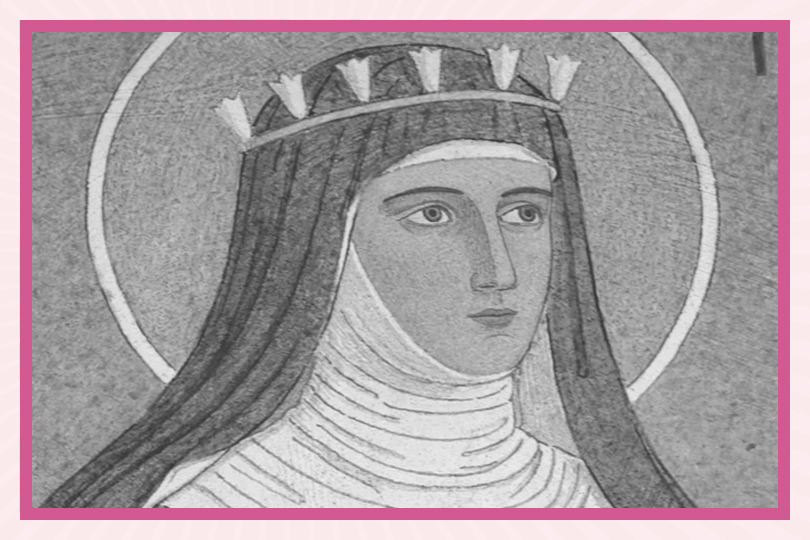By Sienna Vittoria Asselin
More than 800 years ago, a powerful German woman ruled over a large community of women, penned important treatises, composed beautiful music, and advised kings and popes alike. Who was this medieval powerhouse? Read on for a look at the life and legacy of the fascinating and underrated twelfth-century Hildegard of Bingen.
The early years
Hildegard of Bingen—also known as Saint Hildegard in a religious context, or Hildegard von Bingen in its original German form—was born in 1098 to an upper-class German family. We know that she was her parent’s tenth child, and that she suffered from terrible illnesses and migraines from a young age.
When she was around three or four years old, she reportedly began to have strange visions. When her governess and mother found out, they knew she was special, believing the visions must have come from God. Hildegard was therefore placed in a Benedictine convent in Disibodenberg to be educated by Jutta von Sponheim, a young abbess known as one of the brightest minds of her time.
The institution of the convent itself has a fascinating history that is worth dwelling on for a moment, to better understand Hildegard’s story. On one hand, we often hear stories of young and disobedient girls thrown into nunneries and locked away against their will, where they languished in undesired and monotonous lives of prayer and self-deprivation. But on the other hand, nunneries served several important needs for medieval women that often go unappreciated. According to historians Frances and Joseph Gies, the convent provided an alternative to marriage for women who were unable to find a husband or who did not want to marry at all.
They write in Women in the Middle Ages that the nunnery was often a “refuge of female intellectuals.” By becoming a nun, you could pursue your education, rise to a position of administrative leadership, and engage in intellectual or artistic pursuits. Likewise, historian Eileen Power writes that joining the convent in the Middle Ages could be a personal choice that opened the door to a profession of sorts, providing opportunities for education and a “career” that was otherwise unavailable to women. In this Hildegard-themed episode of the BBC History Extra Podcast, Dr Janina Ramirez goes as far as to dub medieval convents as the modern equivalent of a university for women.
For young Hildegard, this opportunity provided her with an important start. She was taken under the wing of Jutta and taught how to read, write, and to play music. She was also instructed by a monk named Volmar, who is perhaps the one who taught her Latin and continued to cultivate her intellect and later encouraged her to begin to write herself. These two mentors supported her and built her up over the years.
Hildegard’s blossoming career
Around the year 1112, she formally entered the convent as a nun. The years went by, and Hildegard continued to devour literature, theology, and other scholarly works, cultivating her intellect and knowledge. She persevered in a devoted life of prayer and followed the rhythmical way of life in a Benedictine convent, where meals, prayer, and work times were set in a cyclical schedule.
According to scholar Michael Embrach in his biographical sketch of Hildegard’s life, we don’t know a lot about these years, but we do know that she became an integral part of her religious community. She lived for 24 years under the mentorship of Jutta, who was visited by people from far and wide for her advice on faith and life.
By the time Jutta died in 1136, the sisters elected Hildegard as her successor. By now, she was 38 years old.
Under Hildegard’s leadership, the convent grew and developed. She introduced significant reforms, removing the strict rules around food, and shortening the excessively long times of prayer and worship. According to Embrach, these changes demonstrated her appreciation for the physical and health needs of her community, and her belief that the human body was the “temple of the Holy Spirit” and not the “tomb of the soul.”
As she got older, her visions became more intense and regular. When she was 42 years old, she began writing formally. Over the next 10 years, she worked on her best-known work, the Scivias, in which she documented her visions and thoughts.
This book garnered the attention of important religious and secular authorities of the time and even the pope gave his stamp of approval, giving her work legitimacy.
At around the same time as she was producing the Scivias, she also decided to take on the enormous initiative of building her own convent, Rupertsberg, located near Bingen. The remote convent that she had been presiding over had become too small for her, and in this new, more central location, she had better access to the Central Rhine, where she could connect with religious and secular powers.
A medieval celebrity
Hildegard’s life is exceptional in its length. Defying the common medieval life expectancy, she lived to her eighties.
Throughout the years, she continued to produce important writing on various topics, eventually leaving behind a wide oeuvre of works.
In her theological writings, she explored themes such as the feminine nature of God, depicted as a nurturing mother, and she reinterpreted scripture from a female perspective.
She also wrote scientific treaties about natural history and the medicinal use of plants, animals, trees, and stones. Interestingly, her writings contain relatively positive views of human sexuality, particularly from the female perspective, and contain the first description of the female orgasm. Hildegard also became known as a healer, and she is said to have cured people with her touch and with her medical knowledge. Her “miracles” were recorded and led to later attempts to canonize her and declare her officially as a saint.
Furthermore, Hildegard excelled as a musician and composed an important body of music. She is considered one of the foremost female composers of the Middle Ages and her music is still appreciated today.
She also undertook several preaching trips over the course of her life, traveling to various destinations to help resolve conflicts. According to Embrach, she gave spiritual lectures in front of churchmen and laypeople in which she discussed structural errors and negative developments in the church, or in the world.
Hildegard became famous in her time, and her correspondence included four popes, two emperors, several kings and queens, dukes, counts, abbesses, the masters of the University of Paris, and prelates. She wasn’t shy in warning important men when they were going off course and often advised people on political situations.
Later years and legacy
In her old age, Hildegard’s illnesses grew worse and on September 17, 1179, she died amongst her fellow sisters at Rupertsberg at the astonishing age of 81 years old. Her gravesite instantly became an important site of prayer and devotion.
As one of the most powerful and fascinating women of the Middle Ages, Hildegard garnered renewed interest in the 20th century. Her works were translated into English, her music was recorded and made available for people to listen to, and she became of particular interest to feminist scholars for her bold writing and inspiring career. Her story proves that despite popular conceptions that suggest otherwise, women could, and did, live extraordinary lives in the Middle Ages.












